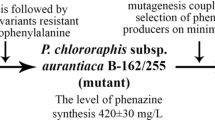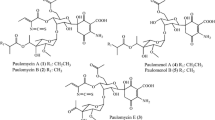Abstract
N-methyl-N′-nitro-N-nitrosoguanidine (NG)-induced mutagenesis with subsequent selection for resistance to toxic amino acid analogues (azaserine, m-fluoro-DL-phenylalanine, and 6-diazo-5-oxo-L-norleucine) was applied to Pseudomonas aurantiaca B-162. The resulting strains produced phenazine antibiotics three times more efficiently than the wild type strain and ten times more efficiently than the known pseudomonad strains. Overproduction of phenazine antibiotics was shown to result either from deregulation of 3-deoxy-D-arabinohepulosonate-7-phosphate synthase (DAHP synthase), the key enzyme of the aromatic pathway (removal of inhibition by phenylalanine, tyrosine, and phenazine), or overproduction of N-hexanoyl homoserine lactone, the regulatory molecules of positive control of cellular metabolism (QS systems).
Similar content being viewed by others
References
Cook, R.J., Thomashow, L.S., Weller, D.M., Fujimoto, D., Mazzola, M., Bangera, G., and Kim, D.S., Molecular Mechanisms of Defense by Rhizobacteria Against Root Disease, Proc. Natl. Acad. Sci. USA, 1995, vol. 92, no. 10, pp. 4197–4201.
El-Banna, N. and Winkelmann, G., Pyrrolnitrin from Burkholderia cepacia: Antibiotic Activity Against Fungi and Novel Activities Against Streptomycetes, J. Appl. Microbiol., 1998, vol. 85, no. 1, pp. 69–78.
Whipps, J.M., Microbial Interactions and Biocontrol in the Rhizosphere, J. Experim. Bot., 2001, vol. 52, no. 1, pp. 487–511.
Dwivedi, D., Johri. B.N. Antifungals from Fluorescent Pseudomonads: Biosynthesis and Regulation, Curr. Sci., 2003, vol. 85, no. 12, pp. 1693–1703.
Mavrodi, D.V., Bleimling, N., Thomashow, L.S., and Blankenfeldt, W., The Purification, Crystallization and Preliminary Structural Characterization of PhzF, a Key Enzyme in the Phenazine-Biosynthesis Pathway from Pseudomonas fluorescens 2-79, Acta Crystallogr., 2004, vol. 60, no. 1, p. 184–186.
Mavrodi, D.V., Ksenzenko, V.N., Bonsall, R.F., Cook, R.J., Boronin, A.M., and Thomashow, L.S., A Seven-Gene Locus for Synthesis of Phenazine-1-Carboxylic Acid by Peudomonas fluorescens 2-79, J. Bacteriol., 1998, vol. 180, no. 9, pp. 2541–2548.
Hassan, H.M. and Fridovich, I., Mechanism of the Antibiotic Action of Pyocyanine, J. Bacteriol., 1980, vol. 141, no. 1, pp. 156–163.
Ahmad, S., Weisburg, W., and Jensen, R., Evolution of Aromatic Amino Acid Biosynthesis and Application to the Fine-Tuned Phylogenetic Positioning of Enteric Bacteria, J. Bacteriol., 1990, vol. 172, no. 2, pp. 1051–1061.
Maksimova, N.P., Olekhnovich, I.N., and Fomichev, Yu.K., Regulation of 3-deoxy-D-arabinoheptulose-7-phosphate Synthase Synthesis in Pseudomonas Bacteria, Genetika, 1991, vol. 27, no. 2, pp. 217–221.
Haas, D., Blumer, C., and Keel, C., Biocontrol Ability of Fluorescent Pseudomonads Genetically Dissecred: Importance of Positive Feedback Regulation, Curr. Opin. Biotechnol., 2000, vol. 11, no. 3, pp. 290–297.
Haas, D. and Keel, C., Regulation of Antibiotic Production in Root-Colonizing Pseudomonas spp. and Relevance for Biological Control of Plant Disease, Annu. Rev. Phytopathol., 2003, vol. 41, no. 1, pp. 117–153.
Feklistova, I.N. and Maksimova, N.P., Synthesis of Phenazine Compounds by Pseudomonas aurantiaca, Vest. Belorus. Un-ta, Ser. 2: Chemistry. Biology. Geography, 2005, no. 2, pp. 66–69.
Sambrook, J., Fritsch, E.F., and Maniatis, T., Molecular Cloning: A Laboratory Manual, Cold Spring Harbor, New York: Cold Spring Harbor Lab., 1989.
Levitch, M.E., Regulation of Aromatic Amino Acid Biosynthesis in Phenazine-Producing Strains, J. Bacteriol., 1970, vol. 103, no. 1, pp. 16–19.
Jensen, R.A. and Nester, E.W., Regulatory Enzymes of Aromatic Amino Acid Biosynthesis in Bacillus subtilis, J. Biol. Chem., 1966, vol. 241, no. 14, pp. 3365–3372.
McClean, K.H., Winson, M., Fish, L., Taylor, A., Chhabra, S.R., Camara, M., Daykin, M., Lamb, J.H., Swift, S., Bycroft, B.W., Stewart, G.S.A.B., and Williams, P., Bycroft, B.W., Stewart, G.S.A.B., and Williams, P., Quorum Sensing and Chromobacterium violaceum: Exploitation of Violacein Production and Inhibition for the Detection of N-Acylhomoserine Lactones, Microbiology (UK), 1997, vol. 143, no. 12, pp. 3703–3711.
Huang, Z., Bonsall, R.F., Mavrodi, D.V., Weller, D.M., and Thomashow, L.S., Transformation of Pseudomonas fluorescens with Genes for Biosynthesis of Phenazine-1-Carboxylic Acid Improves Biocontrol of Rhizoctonia Root Rot and in situ Antibiotic Production, FEMS Microbiol. Ecol., 2004, vol. 49, no. 1, pp. 243–251.
Wood, D., Gong, F., Daykin, M., Williams, P., and Pierson, L.S., N-Acyl-Homoserine Lactone-Mediated Regulation of Phenazine Gene Expression by Pseudomonas aureofaciens 30–84 in the Wheat Rhizosphere, J. Bacteriol., 1997, vol. 179, no. 24, pp. 7663–7670.
Hermann, K.M., Biochemical and Genetic Studies of Aromatic Amino Acid Biosynthesis, J. Biochem., 1966, vol. 315, pp. 494–498.
Bertani, I. and Venturi, V., Regulation of the N-Acyl Homoserine Lactone-Dependent Quorum-Sensing System in Rhizosphere Pseudomonas putida WCS358 and Cross-Talk with the Stationary-Phase RpoS Sigma Factor and the Global Regulator GacA, Appl. Environ. Microbiol., 2004, vol. 70, no. 9, pp. 5493–5502.
Ge, Y., Huang, X., Wang, S., Zhang, X., and Xu, Y., Phenazine-1-Carboxylic Acid Is Negatively Regulated and Pyoluteorin Regulated by gacA in Pseudomonas sp. M18, FEMS Microbiol. Letts., 2004, vol. 237, no. 1, pp. 41–47.
Author information
Authors and Affiliations
Corresponding author
Additional information
Original Russian Text © I.N. Feklistova, N.P. Maksimova, 2008, published in Mikrobiologiya, 2008, Vol. 77, No. 2, pp. 207–212.
Rights and permissions
About this article
Cite this article
Feklistova, I.N., Maksimova, N.P. Obtaining Pseudomonas aurantiaca strains capable of overproduction of phenazine antibiotics. Microbiology 77, 176–180 (2008). https://doi.org/10.1134/S0026261708020094
Received:
Published:
Issue Date:
DOI: https://doi.org/10.1134/S0026261708020094




